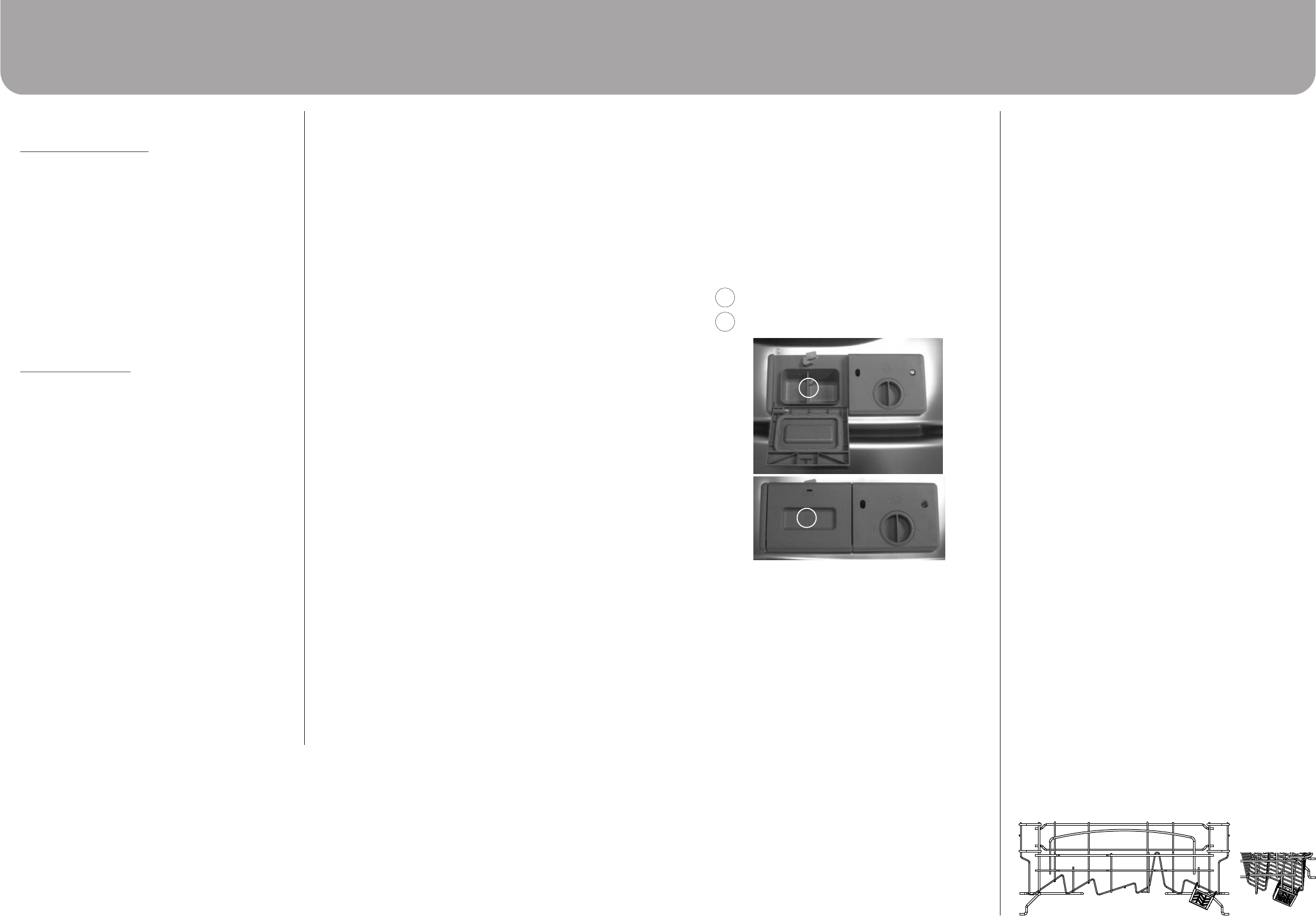
Using Your Dishwasher
Page 11Page 14
Use of “2-in-1”, 3-in-1”, “4-in-1” and “5-in-1”
Combination / Compact Detergents.
These products are detergents with integrated and
combined detergent/rinse aid and salt functions.
Before using these products you should first check
that the water hardness in your supply is compatible
with the use of these products as per the detergent
manufacturers (on the product packaging).
These products should be strictly used according to
the detergent manufacturer's instructions. In general
detergents that include rinse aid or water softener are
only able to serve good results under certain
conditions: rinse aid and water softener can not
adapted to specific conditions. For this reasons in
some cases there might be unwanted cleaning or
drying results.
Please ask the detergent manufacturer to inform you
about the best consume conditions. If you encounter
problems when using these products for the first time
then please contact the detergent manufacturers
care line. The manufacturer of your dishwasher is not
liable for damages caused by compact detergents
nor gives warranty if you use compact detergents.
NOTE: When using “2-in-1”,“3-in-1”,“4-in-1” or “5-
in-1” Combination / Compact Detergents, please pay
attention to make sure that the size of the
Combination Detergents is fitted to the dispenser so
that Combination Detergents can be easy to put in
the dispenser and dispenser would not be broken.
ATTENTION! Keep all detergents in a safe place out
of children's reach.
Always add the detergent in the dispenser just before
starting the dishwasher.
How to use the 3-in-1 Program
Your dishwasher has a 3-in-1 program which needs
no salt and rinse aid but a 3-in-1 tablet. This
dishwasher comes with a 3-in-1 tablet container as
an accessory.
NOTE: Only the 3-in-1 program can be used with 3-
in-1 tablets. If you use 3-in-1 tablets in other
programs, the appliance will not achieve a good
performance.
1. The figure below shows how to hang the 3-in-1
tablet container on the upper basket.
Using Your Dishwasher
Suitability of items for use in your Dishwasher
Ÿ
Ÿ
Ÿ
Ÿ
Ÿ
Ÿ
Ÿ
Ÿ
Ÿ
NOT SUITABLE FOR USE
Cutlery with wooden, horn china or m o t h e r - o f -
pearl handles.
Plastic items that are not heat resistant.
Older cutlery with glued parts that are not
temperature resistant.
Bonded cutlery items or dishes.
Pewter or copper items.
Crystal glass.
Steel items subject to rusting.
Wooden platters.
Items made from synthetic fibres.
LIMITED SUITABILITY
Some types of glasses can become dull after a
Ÿ
large number of washes.
Silver and aluminum parts have a tendency to
Ÿ
discolour during washing.
Glazed patterns may fade if machine washed
Ÿ
frequently.
NOTE:
Do not put in items that are dirty with cigarette ash,
Ÿ
candle wax, lacquer or paint.
If you buy new dishes please make sure that they
Ÿ
are suitable for dishwashers.
Please do not overload your dishwasher. Do not
Ÿ
use dishes that are not suitable for dishwashers.
This is important for good results and for
reasonable energy consumption.
Before loading the dishes, you should:
Remove large food particles.
Ÿ
Soften remnants of burnt food in pans.
Ÿ
When loading the dishes and cutlery, please note:
Dishes and cutlery must not impede the rotation of
Ÿ
the spray arms.
Load hollow items such as cups, glasses, pans etc.
Ÿ
with the opening downwards so that water cannot
collect in the container or a deep base.
Dishes and items of cutlery must not lie inside one
Ÿ
another, or cover each other.
To avoid damage to glasses, they must not touch.
Ÿ
Load large items which are most difficult to clean
Ÿ
into the lower rack.
The upper rack is designed to hold more delicate
Ÿ
and lighter dishware such as glasses, coffee and
tea cups.
Long bladed knives stored in an upright position are
a potential hazard!
Long and/or sharp items of cutlery such as carving
knives must be positioned horizontally in the upper
basket.
Damage to glassware and other dishes
Possible Causes
Type of glass or manufacturing process. Chemical
Ÿ
composition of detergent.
Water temperature and duration of dishwasher
Ÿ
program.
Suggested remedy:
Use glassware or porcelain dishes that have been
Ÿ
marked dishwasher-proof by the manufacturer
Use a mild detergent that is described as kind of
Ÿ
dishes If necessary, seek further information from
detergent manufacturers.
Select a program with as low a temperature.
Ÿ
To prevent damage, take glass and cutlery out of
Ÿ
the dishwasher as soon as possible after the
program has ended. as possible after the program
has ended.
ATTENTION!
Ÿ
Ÿ
B
A
Location of main wash cycle detergent.
Location of pre-wash cycle detergent.
Please observe the manufacturers dosing and
storage recommendations as stated on the detergent
packaging.
Close the lid and press until it locks in place.
If the dishes are heavily soiled, place an additional
detergent dose in the pre-wash detergent chamber.
This detergent will take effect during the pre-wash
phase.
NOTE: See information about the amount of
detergent for the single programs on page 15. Please
be aware, that according to the level soiling and the
specific hardness of water differences are possible.
P l e a s e o b s e r v e t h e m a n u f a c t u r e r ' s
recommendations on the detergent packaging.
A
B
WARNING! Dishwasher detergent is poisonous! Take
care to keep it out of reach of children.
Proper Use of Detergent
Only use detergent specifically made for the use in
Ÿ
dishwashers. Keep your detergent fresh and dry.
Don't put powdered detergent into the dispenser
Ÿ
until you're ready to wash dishes.
Fill the detergent dispenser with detergent. The
marking indicates the dosing levels, as shown below:














